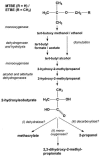The alkyl tert-butyl ether intermediate 2-hydroxyisobutyrate is degraded via a novel cobalamin-dependent mutase pathway
- PMID: 16751524
- PMCID: PMC1489616
- DOI: 10.1128/AEM.00080-06
The alkyl tert-butyl ether intermediate 2-hydroxyisobutyrate is degraded via a novel cobalamin-dependent mutase pathway
Abstract
Fuel oxygenates such as methyl and ethyl tert-butyl ether (MTBE and ETBE, respectively) are degraded only by a limited number of bacterial strains. The aerobic pathway is generally thought to run via tert-butyl alcohol (TBA) and 2-hydroxyisobutyrate (2-HIBA), whereas further steps are unclear. We have now demonstrated for the newly isolated beta-proteobacterial strains L108 and L10, as well as for the closely related strain CIP I-2052, that 2-HIBA was degraded by a cobalamin-dependent enzymatic step. In these strains, growth on substrates containing the tert-butyl moiety, such as MTBE, TBA, and 2-HIBA, was strictly dependent on cobalt, which could be replaced by cobalamin. Tandem mass spectrometry identified a 2-HIBA-induced protein with high similarity to a peptide whose gene sequence was found in the finished genome of the MTBE-degrading strain Methylibium petroleiphilum PM1. Alignment analysis identified it as the small subunit of isobutyryl-coenzyme A (CoA) mutase (ICM; EC 5.4.99.13), which is a cobalamin-containing carbon skeleton-rearranging enzyme, originally described only in Streptomyces spp. Sequencing of the genes of both ICM subunits from strain L108 revealed nearly 100% identity with the corresponding peptide sequences from M. petroleiphilum PM1, suggesting a horizontal gene transfer event to have occurred between these strains. Enzyme activity was demonstrated in crude extracts of induced cells of strains L108 and L10, transforming 2-HIBA into 3-hydroxybutyrate in the presence of CoA and ATP. The physiological and evolutionary aspects of this novel pathway involved in MTBE and ETBE metabolism are discussed.
Figures






Similar articles
-
Degradation of fuel oxygenates and their main intermediates by Aquincola tertiaricarbonis L108.Microbiology (Reading). 2008 May;154(Pt 5):1414-1421. doi: 10.1099/mic.0.2007/014159-0. Microbiology (Reading). 2008. PMID: 18451050
-
Biotransformation of 12C- and 2-13C-labeled methyl tert-butyl ether, ethyl tert-butyl ether, and tert-butyl alcohol in rats: identification of metabolites in urine by 13C nuclear magnetic resonance and gas chromatography/mass spectrometry.Chem Res Toxicol. 1998 Jun;11(6):651-8. doi: 10.1021/tx970215v. Chem Res Toxicol. 1998. PMID: 9625733
-
Biodegradation of the gasoline oxygenates methyl tert-butyl ether, ethyl tert-butyl ether, and tert-amyl methyl ether by propane-oxidizing bacteria.Appl Environ Microbiol. 1997 Nov;63(11):4216-22. doi: 10.1128/aem.63.11.4216-4222.1997. Appl Environ Microbiol. 1997. PMID: 9361407 Free PMC article.
-
Microbial degradation of methyl tert-butyl ether and tert-butyl alcohol in the subsurface.J Contam Hydrol. 2004 Jun;70(3-4):173-203. doi: 10.1016/j.jconhyd.2003.09.001. J Contam Hydrol. 2004. PMID: 15134874 Review.
-
Biodegradation and fate of ethyl tert-butyl ether (ETBE) in soil and groundwater: A review.J Hazard Mater. 2020 Jun 5;391:122046. doi: 10.1016/j.jhazmat.2020.122046. Epub 2020 Jan 24. J Hazard Mater. 2020. PMID: 32145642 Review.
Cited by
-
Structural basis of the stereospecificity of bacterial B12-dependent 2-hydroxyisobutyryl-CoA mutase.J Biol Chem. 2015 Apr 10;290(15):9727-37. doi: 10.1074/jbc.M115.645689. Epub 2015 Feb 26. J Biol Chem. 2015. PMID: 25720495 Free PMC article.
-
Engineered and Native Coenzyme B12-dependent Isovaleryl-CoA/Pivalyl-CoA Mutase.J Biol Chem. 2015 Aug 14;290(33):20466-76. doi: 10.1074/jbc.M115.646299. Epub 2015 Jul 1. J Biol Chem. 2015. PMID: 26134562 Free PMC article.
-
Synthesis of short-chain diols and unsaturated alcohols from secondary alcohol substrates by the Rieske nonheme mononuclear iron oxygenase MdpJ.Appl Environ Microbiol. 2012 Sep;78(17):6280-4. doi: 10.1128/AEM.01434-12. Epub 2012 Jun 29. Appl Environ Microbiol. 2012. PMID: 22752178 Free PMC article.
-
Novel coenzyme B12-dependent interconversion of isovaleryl-CoA and pivalyl-CoA.J Biol Chem. 2012 Feb 3;287(6):3723-32. doi: 10.1074/jbc.M111.320051. Epub 2011 Dec 13. J Biol Chem. 2012. PMID: 22167181 Free PMC article.
-
A Review of the Biotechnological Production of Methacrylic Acid.Front Bioeng Biotechnol. 2020 Mar 20;8:207. doi: 10.3389/fbioe.2020.00207. eCollection 2020. Front Bioeng Biotechnol. 2020. PMID: 32266236 Free PMC article. Review.
References
-
- Achten, C., A. Kolb, and W. Puttmann. 2002. Occurrence of methyl tert-butyl ether (MTBE) in riverbank filtered water and drinking water produced by riverbank filtration. 2. Environ. Sci. Technol. 36:3662-3670. - PubMed
-
- Andersen, M. D., P. K. Busk, I. Svendsen, and B. L. Møller. 2000. Cytochromes P-450 from cassava (Manihot esculenta Crantz) catalyzing the first steps in the biosynthesis of the cyanogenic glucosides linamarin and lotaustralin. J. Biol. Chem. 275:1966-1975. - PubMed
-
- Banerjee, A., R. Sharma, and U. C. Banerjee. 2002. The nitrile-degrading enzymes: current status and future prospects. Appl. Microbiol. Biotechnol. 60:33-44. - PubMed
-
- Benndorf, D., I. Davidson, and W. Babel. 2004. Regulation of catabolic enzymes during long-term exposure of Delftia acidovorans MC1 to chlorophenoxy herbicides. Microbiology 150:1005-1014. - PubMed
Publication types
MeSH terms
Substances
Associated data
- Actions
- Actions
- Actions
LinkOut - more resources
Full Text Sources
Other Literature Sources
Molecular Biology Databases
Miscellaneous

